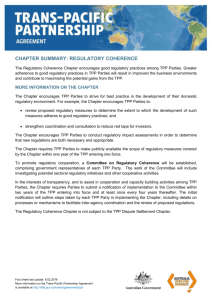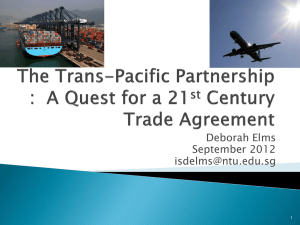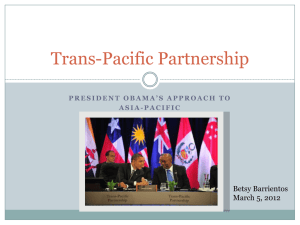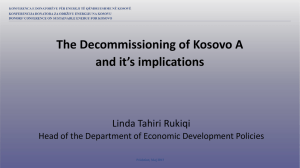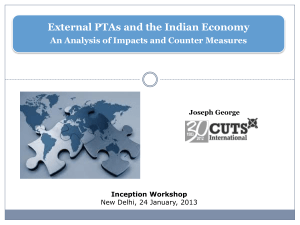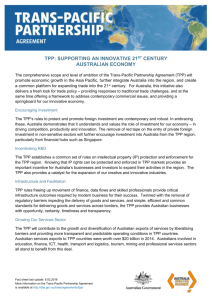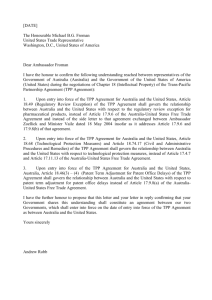chapter summary: environment
advertisement
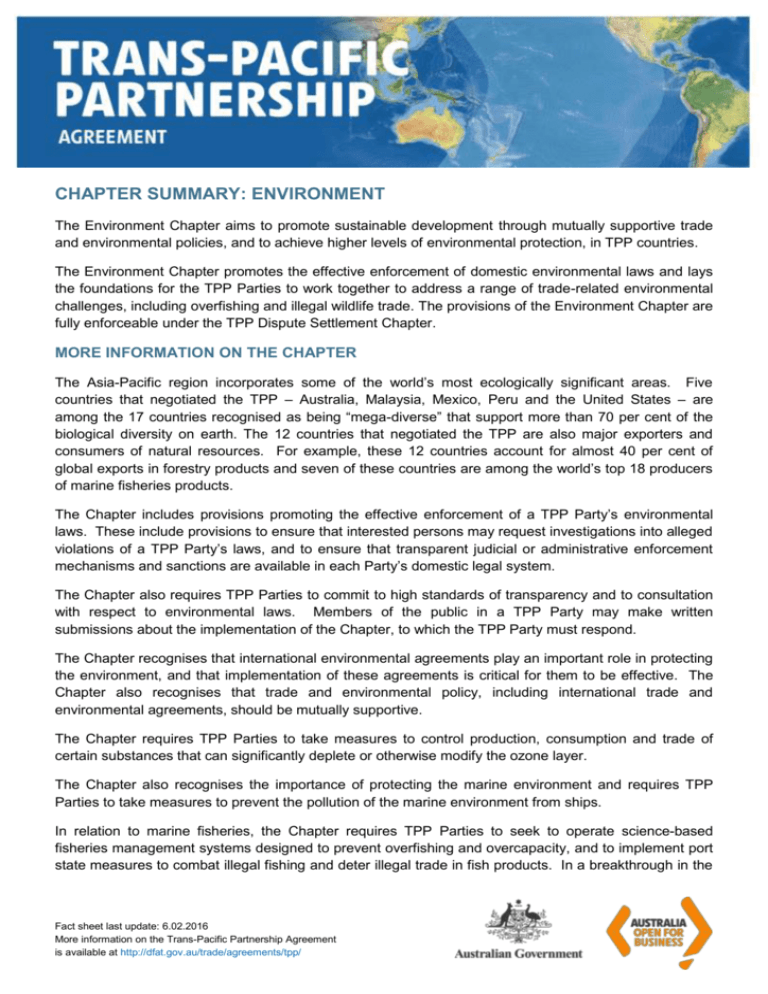
CHAPTER SUMMARY: ENVIRONMENT The Environment Chapter aims to promote sustainable development through mutually supportive trade and environmental policies, and to achieve higher levels of environmental protection, in TPP countries. The Environment Chapter promotes the effective enforcement of domestic environmental laws and lays the foundations for the TPP Parties to work together to address a range of trade-related environmental challenges, including overfishing and illegal wildlife trade. The provisions of the Environment Chapter are fully enforceable under the TPP Dispute Settlement Chapter. MORE INFORMATION ON THE CHAPTER The Asia-Pacific region incorporates some of the world’s most ecologically significant areas. Five countries that negotiated the TPP – Australia, Malaysia, Mexico, Peru and the United States – are among the 17 countries recognised as being “mega-diverse” that support more than 70 per cent of the biological diversity on earth. The 12 countries that negotiated the TPP are also major exporters and consumers of natural resources. For example, these 12 countries account for almost 40 per cent of global exports in forestry products and seven of these countries are among the world’s top 18 producers of marine fisheries products. The Chapter includes provisions promoting the effective enforcement of a TPP Party’s environmental laws. These include provisions to ensure that interested persons may request investigations into alleged violations of a TPP Party’s laws, and to ensure that transparent judicial or administrative enforcement mechanisms and sanctions are available in each Party’s domestic legal system. The Chapter also requires TPP Parties to commit to high standards of transparency and to consultation with respect to environmental laws. Members of the public in a TPP Party may make written submissions about the implementation of the Chapter, to which the TPP Party must respond. The Chapter recognises that international environmental agreements play an important role in protecting the environment, and that implementation of these agreements is critical for them to be effective. The Chapter also recognises that trade and environmental policy, including international trade and environmental agreements, should be mutually supportive. The Chapter requires TPP Parties to take measures to control production, consumption and trade of certain substances that can significantly deplete or otherwise modify the ozone layer. The Chapter also recognises the importance of protecting the marine environment and requires TPP Parties to take measures to prevent the pollution of the marine environment from ships. In relation to marine fisheries, the Chapter requires TPP Parties to seek to operate science-based fisheries management systems designed to prevent overfishing and overcapacity, and to implement port state measures to combat illegal fishing and deter illegal trade in fish products. In a breakthrough in the Fact sheet last update: 6.02.2016 More information on the Trans-Pacific Partnership Agreement is available at http://dfat.gov.au/trade/agreements/tpp/ fight against subsidies that contribute to overfishing, the Chapter requires TPP Parties to prohibit subsidies for fishing that negatively affect overfished stocks and subsidies for vessels engaged in illegal fishing. Under the Chapter, each TPP Party commits to promote the conservation of sharks, marine turtles, sea birds and marine mammals by implementing and enforcing effective conservation and management measures, such as measures to limit by-catch from fishing and finning prohibitions. The Chapter includes a range of commitments to promote the conservation of wild flora and fauna. Each TPP Party must take measures to protect at-risk wildlife in its territory, including measures to protect the ecological integrity of designated natural protected areas. In an effort to address illegal trade in wildlife, TPP Parties are required to adopt laws, regulations and other measures to fulfil their obligations under the Convention on International Trade in Endangered Species of Wild Fauna and Flora (CITES). TPP Parties also commit to take measures to combat illegal trade in non-CITES species, including strengthening cooperation in this area. The Chapter includes provisions promoting cooperation among TPP Parties on matters of mutual interest related to the conservation and sustainable use of biological diversity. Areas of cooperation may include protection of ecosystems and access to, and sharing of benefits from the utilisation of, genetic resources. The Chapter also incorporates provisions promoting cooperation among TPP Parties on matters of mutual interest related to transitioning to low emission economies, such as cooperation on clean and renewable energy sources, deforestation and emissions monitoring. The Chapter recognises the importance of working with the private sector and of encouraging enterprises to take corporate social responsibility measures concerning the environment. Other voluntary measures to enhance environmental performance, such as environmental auditing, are also encouraged. The Chapter commits TPP Parties to work together to address potential barriers to trade in environmental goods and services. The Chapter also provides for TPP Parties to undertake cooperative activities related to the implementation of the Chapter, such as workshops, collaborative projects, technical assistance and information exchange. The Chapter is subject to a robust enforcement mechanism that includes a three-step consultation process for TPP Parties to use in seeking to resolve any disputes that may arise. If Parties fail to resolve a dispute through consultations, they may use the procedures in the TPP Dispute Settlement Chapter. Fact sheet last update: 6.02.2016 More information on the Trans-Pacific Partnership Agreement is available at http://dfat.gov.au/trade/agreements/tpp/ 2
